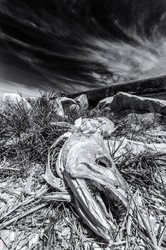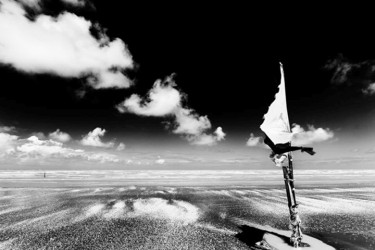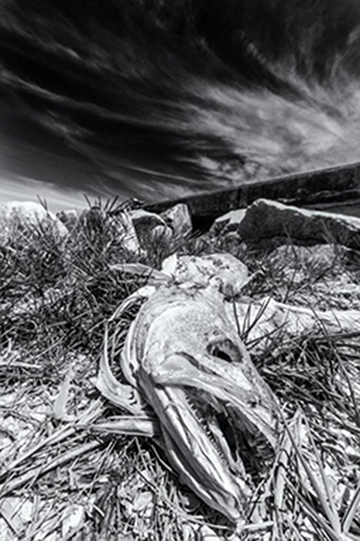The fish is the centre of attention but it is juxtaposed by clouds streaking across a dark sky, signifying a time lapse.
The image composition speaks volumes. Why would a photographer compose such an odd looking shot and what is the significance of the clouds?
Let’s place the fish in human context; death is such a significant part of our lives and when it affects us directly it consumes us, but time keeps moving, seeing us as pitiful and insignificant.
That is why the fish is the centre of the picture and the clouds are in the background. But if we sit and contemplate the significance time plays in our lives, in a few days it will decay and things shall just move on. What will be in focus after the fish rots? Time will be in focus.

You spot something, but you are not sure what it is. As Rafiki from The Lion King said, “Look harder.” The fish is the obviously the main focus, but there is the strong contrast of the seawall and the sky. Now use your imagination and place a human figure on the seawall then cast it in a silhouette. The figure would be looking for the fish. The fish has a vital role to play in the progression of the story; we know that, but the figure doesn’t.
The eeriness of the image creates a haunting feeling. The moving clouds could signify time running out, maybe something criminal has happened, but the fish is positioned so oddly, it will be missed and the mystery will remain unsolved. Maybe there is a severed ear in the fish; or a wedding ring. A good photograph forces you to think.
A minimalist image: There is the cloud again and it appears to be moving. And unlike the previous photograph this image has a lot of negative space and it is not weirdly composed as the other. But the use of leading lines and the positioning of the flag is evocative.
The flag could be someone observing what is transpiring on the seashore.

Leading lines flood this picture and the most obvious is the seashore. It starts from the left and moves into the flag. The flag is positioned as if there’s something far out in the sea that’s vanished and the presence is so strong it’s unwavering.
Interesting also is the leading lines the sand forms, the lines move out into the sea and with them stories that have been washed away and can only be told by the flag. As simple as this image may appear to the eye, it shows the beach is never boring; something is always bubbling underneath.
Oddly enough like all works of art, it reminds me of a famous shot in the 1959 French drama film 400 blows by François Truffaut. I am not going to go into details about that movie, you are ordered to watch it and give your opinion.
For those of you who might have been lost:
Juxtaposition – Two things that are placed together for contrasting effect.
Leading lines – Lines in an image that lead the eye to another point in the image, or occasionally, out of the image. Anything with a definite line can be a leading line. Fences, bridges, even a shoreline can lead the eye.
Negative Space – The area around the subject, or area of interest. (Rae Wiltshire)






